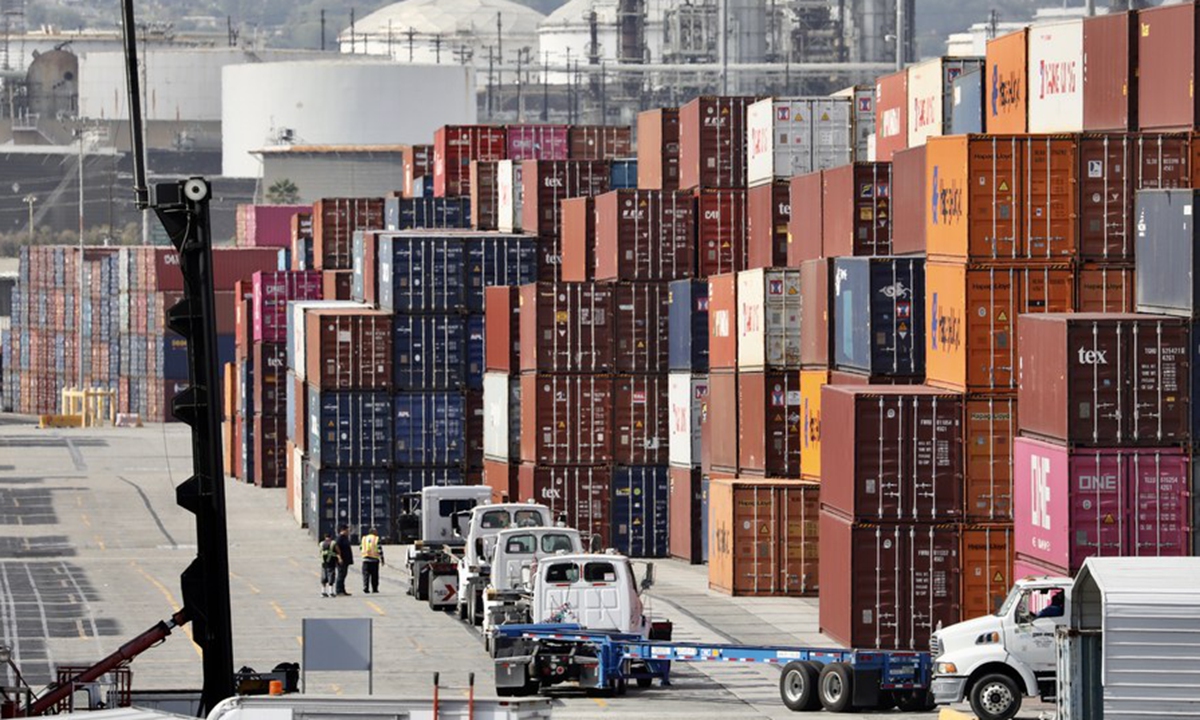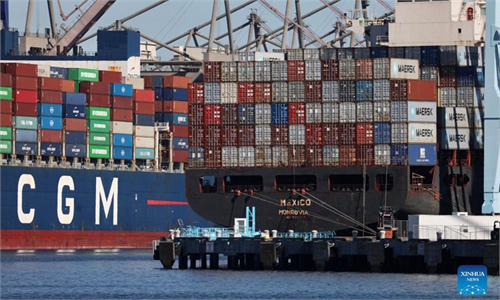
Trucks wait to load containers at the port of Los Angeles, California, the US, on Oct. 22, 2021. Photo: Xinhua
In 2020, the global economy came to a screeching halt due to the COVID-19 pandemic. While the economy is beginning to recover, the supply chain is facing the most serious backlog in history.The global supply-chain snarl is worsening, particularly in the UK, the US and other Western countries. Supermarkets in Britain are struggling with toilet-roll shortage, KFC in America is running out of chicken, countless Christmas goods are piling up on the docks, and car companies are cutting back production.
Some people put the blame for the supply-chain chaos on the coronavirus and the globalization of supply chains, and preach about the necessity to transfer supply chains back to America. But the truth is, the unilateral practices, trade protectionist measures and excessive financial stimulus adopted by the US government, as part of its "America First" agenda that has been guiding its policy in recent years, are the exact causes of the growing vulnerability of supply chains.
Either during the Biden or Trump administration, the ill-advised economic policies of the US has caused turbulence in the global supply chain. Donald Trump held the "tariff stick" and waged trade war all over the world. Although President Joe Biden has introduced some remedy measures, including canceling Trump's punitive tariffs on European steel and aluminum, he seems reluctant to revoke Trump's $300 billion tariff on imports from China.
Up to now, the US has put more than 900 Chinese companies and agencies on the entity list. Moreover, it seeks to establish a supply chain independent from the global supply chain, with the US sitting at the center and choosing "satellite economies" at its will. These anti-globalization practices have twisted the global supply chain, increased the inflationary pressure on the US, and greatly harmed the interests of global consumers.
The US trade protectionism and unilateralism are also the reasons behind the global chip shortage. The US keeps adding Chinese high-tech enterprises to the restricted trade list, banning trade between American high-tech companies and Chinese companies on the ground of national security, and subjecting non-American companies to its long-arm jurisdiction.
However, when demands for electronic products and cars soared, the semiconductor foundries failed to respond in time, which in turn impacted on the production of American companies. As the South China Morning Post and Reuters commented, the chip shortage has grown worse as a result of the US tech war against China. According to the latest data, more than 169 industries worldwide have been affected by the shortage. The pursuit of selfish interests, with no regard for the consequences, will eventually backfire.
The excessive financial stimulus measures taken by the US government have led to a more shaky supply chain. The National Retail Federation (NRF) estimates that US sales for November and December will grow between 8.5 percent and 10.5 percent, reaching a record high of $859 billion. The unemployment benefits introduced during the pandemic have contributed "significantly" to the ongoing labor shortage, and the labor force participation rate has dropped to the lowest level since the 1970s. The Job Openings and Labor Turnover Survey of the US Labor Department shows 10.44 million vacancies in August. The apparent lag in labor force participation rate has aggravated the tension between demand and supply.
The mishandling of COVID-19 by the US government has put great pressure on ports and logistics, making it the weakest link in the global supply chain. More than 70 container ships are now stuck off the Southern California coast amid the supply chain crisis, exacerbating the tension in supply chains and making it difficult for terminals to operate normally. If the containers on these ships were unloaded and their contents laid end to end, it would stretch from Southern California to Chicago, or more than 3,000 kilometers, according to analysis from Bloomberg.
The new global Container Port Performance Index (CPPI) released by the World Bank and IHS Markit puts the POLA and POLB close to the bottom among all the world's major ports, while Asian ports have taken nine spots in the top 10 list. To make things worse, the US is facing an extreme shortage of logistics workers, with a gap of more than 80,000 truck drivers. US Secretary of Transportation Pete Buttigieg suggested that the supply chain woes could last until next year.
In striking contrast with the US, China is the first country to put the pandemic under control and achieve economic reopening in an orderly way, serving as an anchor of the global supply chain. In 2020, China recorded 14.55 billion tons of port cargo throughput, ranking first in the world, but it has never had any sustained congestion like the one happening in the US. Through its own production capacity, China has helped neighboring countries fight the pandemic and resume production. Up to October 27, China had provided multiple batches of anti-epidemic supplies to 28 neighboring countries and regions, delivered 10 batches of COVID vaccine totaling more than 80 million doses, and sent more than 10 medical expert teams.
Through the Belt and Road Initiative, China has contributed to the smooth functioning of trade and transportation channels, supported the economic reopening in countries along the routes, and provided essential support for the stability of the global supply chain. The pandemic has further underscored the resilience of China's supply chain and its indispensable role in the global supply chain.
Nowadays, globalization has penetrated into all fields of production, circulation and consumption. If the US continues to go against the tide, its economy will surely suffer greater losses. What the US should do is to solve the problems with its own domestic governance, rather than make the world pay for the cost of the dollar hegemony. In the era of economic globalization, we are all like passengers on the same boat in pursuit of common development. It is therefore imperative that countries jointly manage the impact of the pandemic to promote the early resumption of global industry and supply chains and ensure the steady recovery of the global economy.
The author is a current affairs commentator based in Beijing. opinion@globaltimes.om.cn


